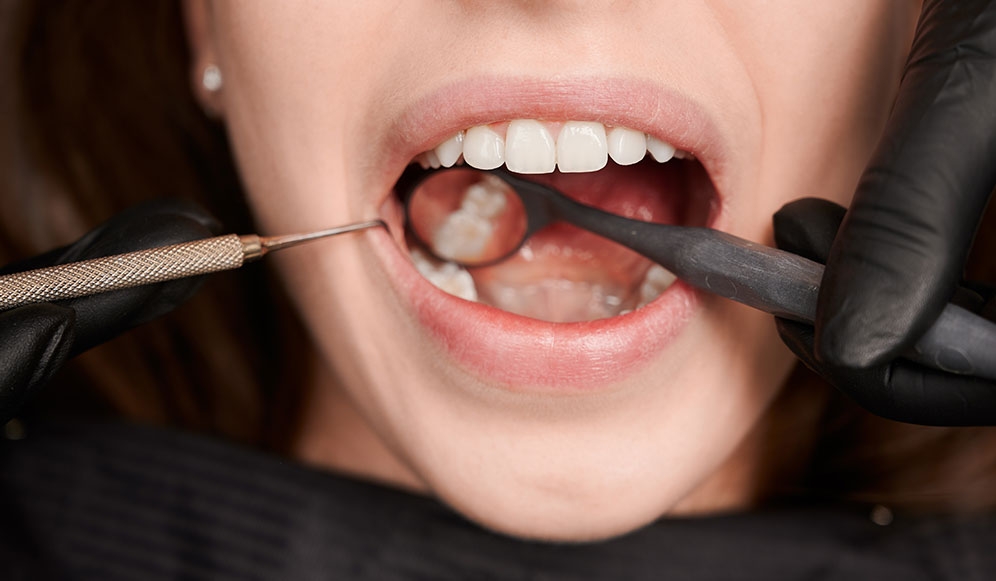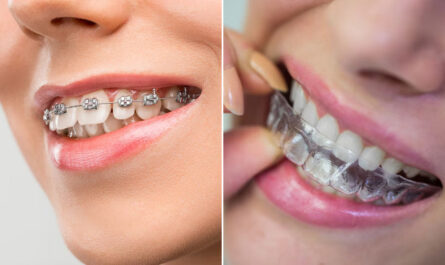Modern aesthetic fillings have revolutionized dental restorations, offering patients in Mumbai natural-looking alternatives to traditional amalgam fillings. At Dr. Irfana’s Dental Studio in Jogeshwari, these invisible restorations not only repair damaged teeth but enhance your smile aesthetically. This comprehensive guide covers everything you need to know about aesthetic fillings, from materials and procedure to longevity and cost considerations in the Mumbai dental market.
1. Understanding Aesthetic vs. Traditional Fillings
Traditional Amalgam Fillings:
- Silver-colored metal alloy (silver, tin, copper, mercury)
- Highly noticeable in the mouth
- Excellent durability (15+ years)
- May require more tooth structure removal
- Temperature-sensitive, can expand/contract
- Lower initial cost
Modern Aesthetic Fillings:
- Tooth-colored materials (composite resin, ceramic, glass ionomer)
- Virtually invisible after placement
- Bonds directly to tooth structure
- Requires minimal tooth preparation
- Insulates against temperature changes
- Mercury-free and environmentally friendly
2. Types of Aesthetic Filling Materials at Dr. Irfana’s Studio
Composite Resin:
- Most commonly used aesthetic filling material
- Excellent for front teeth and visible surfaces
- Direct application and hardening in a single visit
- Moderate lifespan of 1-10 years with proper care
Ceramic/Porcelain Inlays and Onlays:
- Premium indirect restorations crafted in lab
- Superior strength and durability (10-15+ years)
- Highly stain-resistant
- Requires multiple appointments
- Best for larger cavities or damaged cusps
Glass Ionomer Cement:
- Contains fluoride that releases over time
- Best for non-biting surfaces or root cavities
- Ideal for children or high-caries-risk patients
- Less aesthetic than composites, but still tooth-colored
- 3-5 year average lifespan if maintained well
3. The Aesthetic Filling Procedure at Dr. Irfana’s Dental Studio
Initial Assessment:
- Comprehensive dental examination
- Digital radiographs to detect decay extent
- Discussion of material options and costs
- Treatment planning based on location and size of cavity
Treatment Process:
1. Preparation (15-20 minutes):
- Decay removal with minimal healthy tooth structure loss
- Cleaning and preparation of the cavity
2. Filling Placement (20-30 minutes):
- For composite resins:
- Application of bonding agent
- Layering of composite material
- Light-curing of each layer
- Shaping and contouring to match natural tooth anatomy
3. Finishing (10-15 minutes):
- Bite check and adjustment
- Final polishing for natural appearance
- Post-procedure care instructions
Total appointment time: Typically 45-60 minutes for standard fillings
4. Real Patient Cases: Before and After
Case 1: Front Tooth Restoration
30/M patientcame with a chipped front tooth due to a bike accident 2 years ago. The xray showed no nerve involvement and the surrounding structures and gums were healthy. The patient was advised a composite restoration to keep the treatment as minimally invasive as possible.
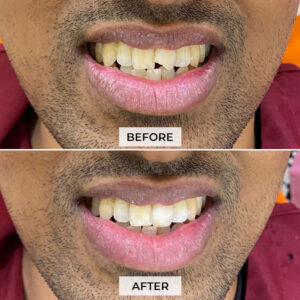
Case 2: 18/F patientcame with a chipped front tooth due to a blunt force trauma a year ago. The xray showed no nerve involvement and the surrounding structures and gums were healthy. The patient was advised a composite restoration to keep the treatment as minimally invasive as possible.
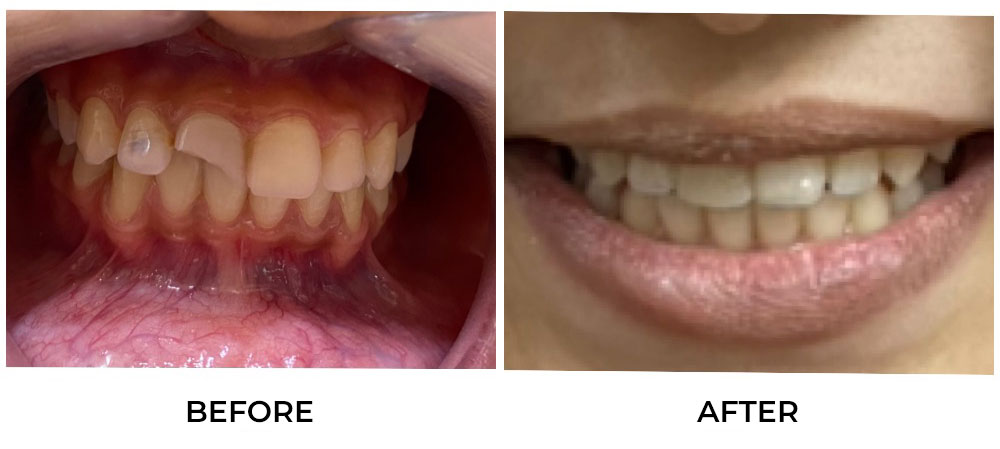
Case 3: Molar Restoration
40/ M patient complained of decayed posterior teeth and food lodgement. Radiograph showed no pulpal involvement hence the caries was excavated and composite filling was done to restore the tooth.
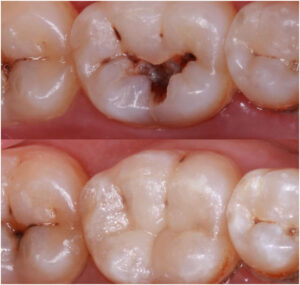
5. Longevity and Maintenance
Expected Lifespan:
- Composite resin: 1-10 years
- Ceramic/porcelain: 10-15+ years
- Glass ionomer: 1-5 years
Factors Affecting Longevity:
- Oral hygiene practices
- Location of filling (biting surfaces wear faster)
- Size of restoration
- Diet and habits (grinding, acidic foods, etc.)
- Regular dental check-ups
Maintenance Tips:
- Brush twice daily with fluoride toothpaste
- Floss daily, especially around filled teeth
- Avoid excessive consumption of staining foods/beverages
- Don’t use teeth as tools to open packages
- Wear night guard if you grind your teeth
- Schedule bi-annual check-ups at Dr. Irfana’s Dental Studio
6. Cost Considerations in Mumbai
Aesthetic filling costs in Mumbai vary based on several factors:
| Material Type | Average Price Range (₹) |
|---|---|
| Composite Resin | Rs 1000- Rs 5000 per tooth |
| Ceramic Inlays/Onlays | Rs 5000- Rs 15000 per tooth |
| Glass Ionomer | Rs 1000 – Rs 2500 per tooth |
Additional factors affecting Cost:
- Extent and depth of the filling
- Location or the surface of tooth involved (eg. Front tooth or back tooth which bear biting forces etc)
- Type, quality and brand of materials used
- Dentist’s expertise and credentials
- Advanced technology used
- Need for additional procedures (e.g., deep cleaning)
7. Why Choose Aesthetic Fillings at Dr. Irfana’s Dental Studio?
- Precision Shade Matching: Our specialized shade-matching system ensures your fillings blend seamlessly with your natural teeth.
- Advanced Materials: We use only the highest quality composite and ceramic materials for lasting results.
- Minimally Invasive Techniques: Our approach preserves maximum healthy tooth structure.
- Digital Dentistry: Advanced scanning and preparation techniques for precise restorations.
- Experienced Team: Irfana brings years of specialized aesthetic dentistry expertise to each restoration.
FAQs
Are aesthetic fillings as strong as metal fillings?
Modern aesthetic materials have significantly improved in strength. While composite resins may not match the durability of amalgam in very large restorations, ceramic options provide comparable strength with superior aesthetics.
How soon can I eat after getting an aesthetic filling?
For composite resin fillings, you can eat immediately after the procedure, though it’s advisable to wait until numbness subsides to avoid accidentally biting your cheek. With ceramic restorations, once they’re permanently cemented, you can resume normal eating.
Will my aesthetic filling change color over time?
Quality composite materials used at Dr. Irfana’s Dental Studio are highly stain-resistant, though they may slightly discolor over many years, especially with consistent exposure to staining foods and beverages. Ceramic restorations are extremely color-stable.
Is the procedure painful?
If the fillings are deep, the procedure is performed under local anesthesia, ensuring you feel no pain during treatment. Some patients may experience mild sensitivity for a few days afterward, which typically resolves quickly.
How do I know if I need a filling or a crown?
The extent of tooth damage determines the appropriate restoration. Generally, if less than 50% of the tooth structure is damaged, a filling is suitable. For more extensive damage, Dr. Irfana may recommend a crown for better protection and longevity.
Final Thoughts
Aesthetic fillings represent the perfect blend of health and beauty in modern dentistry. By choosing invisible restorations at Dr. Irfana’s Dental Studio, you’re not just treating decay,you’re investing in a natural-looking, confidence-boosting smile that supports your overall dental health.
Ready to transform your dental health with invisible restorations? Schedule your consultation at Dr. Irfana’s Dental Studio in Jogeshwari today. Your smile deserves nothing less than excellence.
